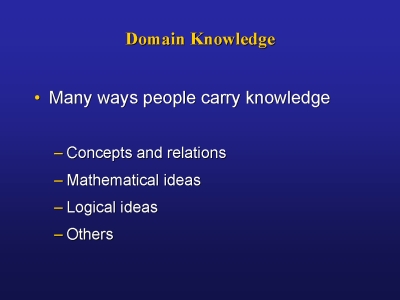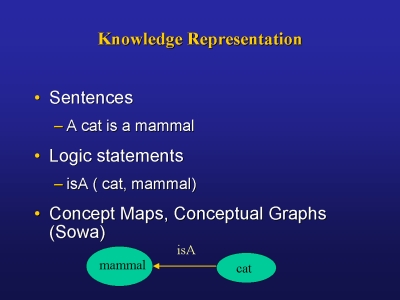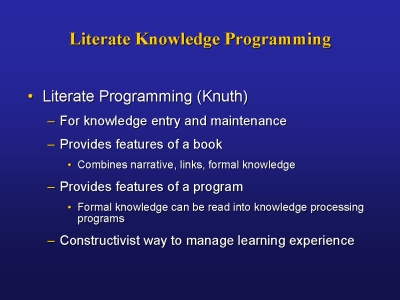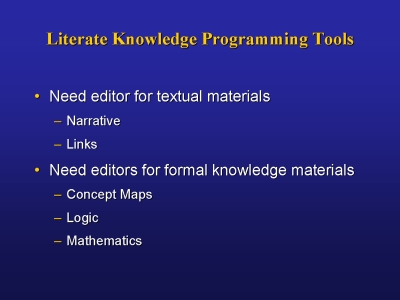Literate Knowledge Programming Jack Park. 1.* - unedited transcript - I have one
objective and not much time. My objective is to introduce the tractor basin
called knowledge representation. I've heard people refer to it as a black
hole. Now, Doug was talking about surgical implants of knowledge devices,
which made me think: "What would an implanted memory device in your tooth
do to oral exams?" There's a timeline that brings me to this session and
I just want to take a brief moment to go through it. In the same year that
I graduated from high school, Doug wrote a paper for the Air Force that
fundamentally described what we're all doing now. Some 25 years later,
I did an expert system for the Air Force that basically that changed my
career path into the area of knowledge representation and that sort of
thing. I later built a program I call the scholar's companion, and it's
whole objective was to enhance the IQ of the individual using it. I spoke
of something called the "Apparent IQ of the Human Computer." Doug speaks
of the collective IQ. So there's a tremendous parallel between what Doug
has been doing and what I've been doing. By the way, there's another parallel:
I used to milk goats.
Student: Are you kidding? Park: No, I'm not. Actually, goats are easier to milk than cows, by the way. What I want to talk about is. Student: (Inaudible) Park: I won't go there.
I see the OHS/DKR package as a knowledge management system in a slightly different way than Doug has been talking about it, and I think that's why he's asked me to speak today.
I say that it can contain domain knowledge of the kind that physicists have, and cow-milkers have and so forth, but the OHS itself can provide us with a knowledge editing/viewing/browsing environment. We're very interested in having multiple ways to view that which we call knowledge. That, in fact, is where I wish to go very briefly. Many people have different ways of carrying their knowledge. We have in this room a brilliant mathematician. I tend to think in terms of concepts and relations. Others think in terms of logical equations. And there are many other ways. We don't have time to go too far into them but let's look at sentences. A big picture.
You think of a cat as a mammal. You can say it in a logical statement. In this case, a prefix variant co-. Where you're expressing that a cat is an animal. Or you can put it out visually in concept maps. I'd like to draw your attention to the fact that almost everything that has been presented to you here has been presented to you visually in almost exactly that form. Now I drew from John F. Sawes concepts, which he calls conceptual graphs. We'll go there just a little bit more. I really want you to recognize the fact that I can represent graphically facts, statements of beliefs, just about anything I want, in a graphical/visual way. But I can also represent it electronically in the memory of the computer.
By the way, that's a hot link so that you can see where I shamelessly copied this graph off the web. You should go and read the whole paper, by the way. I have gone and coupled something Donald Knuth did, called Literate Programming with what I call Knowledge Engineering.
Now, where we're going with this is as follows. Literate Programming allows you to write a document with lots of prose, where you are essentially saying "Here is what I want to do, here is how I'm going to do it, and by the way, here's the code." The neat part about it is that you can send that entire document, through a filter, to a computer, and a compiler will pull the code out and go ahead and build your program. Well, what if we did the same thing with reference to chunks of knowledge, where we were able to write a book, and in that book, have our diagrams, and have those diagrams go directly into the memory of the DKR, and become usable by others. Meanwhile, you still have a text document where other can say, "I see where they came from." One really useful thing about this is that it supports the constructivist way of teaching kids how to do things. The kids can sit there and construct their own little diagrams very similar to the one we saw before. This is a great way for teachers to probe the depths of the knowledge of the child, is to allow them to express it the way a lot of people think, and that's visually.
So we need an editor for textual materials, our narratives, and our links. We need many editors for formal knowledge materials. We need to be able to build concept maps, logic statements, mathematical equations, and so forth. I close with just a little sketch of how my vision of using the OHS: where individuals at a console create a document, write their background narrative, they enter their knowledge structures, and they enter their links, and it becomes a permanent record within the DKR.
That's it.
---
Above space serves to put hyperlinked
targets at the top of the window
|

 Fig. 1
Fig. 1 Fig. 2
Fig. 2 Fig. 3
Fig. 3 Fig. 4
Fig. 4 Fig. 5
Fig. 5 Fig. 6
Fig. 6 Fig. 7
Fig. 7